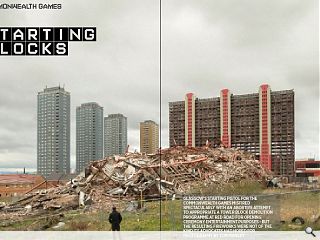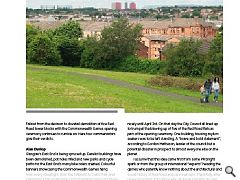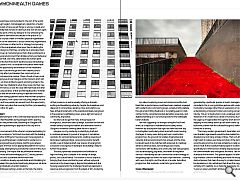Commonwealth Games - Starting Blocks
7 Aug 2014
Glasgow’s starting pistol for the commonwealth games misfired spectacularly with an abortive attempt to appropriate a tower block demolition programme at Red Road for opening ceremony entertainment purposes - but the resulting fireworks were not of the kind its advocates had hoped for. Photography by Tom Manley
Fallout from the decision to dovetail demolition of five Red Road tower blocks with the Commonwealth Games opening ceremony continues to rumble on. Here four commentators give their verdicts.Alan Dunlop
Glasgow’s East End is being spruced up. Derelict buildings have been demolished, pot holes filled and new parks and cycle paths for the East End’s many bike riders created. Colourful banners showcasing the Commonwealth Games hang from every streetlight, from the Tolbooth to Celtic Park and Dalmarnock has undergone a transformation. Red sandstone tenements have been removed, occupants moved on and a velodrome and athletes’ village created in their place.
Everything built for the games is, according to the team at Glasgow 2014, “world class” and the talk in the City Chambers is of “legacy”. One can argue about the meaning of legacy or the real regeneration benefits that the Commonwealth Games might bring, or why it takes an influx of tourist for a city to clean up its back yard. The changes though, for the majority of Glaswegians, are generally welcomed and thousands volunteered to be games helpers.
Preparations for the games seemed to be moving along nicely until April 3rd. On that day the City Council all lined up to trumpet the blowing up of five of the Red Road flats as part of the opening ceremony. One building, housing asylum seekers was to be left standing. A “brave and bold statement”, according to Gordon Matheson, leader of the council but a potential disaster in prospect to almost everyone else on the planet.
I assume that this idea came first from some PR bright spark or from the group of international “experts” heading the games who patently know nothing about the architectural and social history of Red Road and care even less. Thankfully, after universal protest from those who do know and who do care, the city council played its “get out of jail free card”, when its daft proposal was scuppered due to, according to revised PR, legitimate concerns over public safety.
Lee Ivett [BAXENDALE]
I found the idea of using the demolition of Red Road as an element of the Commonwealth Games opening ceremony to be a tactless, mindless show of misguided bravado. As a physical entity Red Road has suffered too many years of institutional neglect to be saved in its current form but making a spectacle of its destruction seemed crass. As part of a global event it would have communicated to the rest of the world, that through neglect, mismanagement, dereliction of public duty, and a lack of care we got things so wrong, so badly and so profoundly that we have to destroy it and start all over again.
In many parts of the city Glasgow is now witnessing the fourth phase of demolition and rebuild in the space of 120 years. This city has a habit of mindless physical regeneration that occurs at the detriment to actual community regeneration. It appears to know no other tactic or strategy for improving the lives of the marginalised urban poor than to destroy the de-humanising box that they currently live in and place them in a brand new de-humanising box that is then positioned in a wider physical environment that dictates activity and behaviour in a manner that, over time, deteriorates the human spirit.
Places like Red Road don’t decline because tall buildings are a bad place to live, it is because those places were made without the opportunity and invitation for the inhabitants to generate a culture through their own creativity and to meaningfully effect and develop their community in an organic and responsive manner. There is floods of new social housing going up all over Glasgow at the moment which will no doubt win their architects awards and bring smiles to the faces of their new inhabitants when they move into their new shiny, warm homes; as was the case with Red Road and other social housing schemes of that era that replaced the Victorian tenements that we are now rushing to replicate once more. Until we start asking questions about what we want people to do in these places, how a place can truly bring delight into the everyday and how people can see and touch the opportunity to create their own place then we may find the cycle repeating itself in another 30 years.
TOM MANLEY
Any sensational impact of the controversial proposal to bring down the Red Road flats during Glasgow 2014’s opening celebrations has proved futile, backfiring on Glasgow’s PR machine and questioning its approach to the city and its residents.
On announcement of the scheme’s original earmarking for demolition, a response “just knock me down with the building – Don’t bother shifting me” becomes ever more poignant as remaining would have been condemned to residence in a globally recognised housing failure, had this gone ahead.
Glasgow 2014 was not an appropriate platform for such a potent display, attempting to promote the reversal of the city’s ill-fated housing. One hopes that any alternative reference would be more self-acknowledging of GCC and its partner’s failure to secure a sustainable environment here.
With conditions already unpredictable and intimidating for asylum seekers this spectacle risked being dangerous, let alone furthering individuals uncertain situations.
As a child approaching London on the train, the drama of similar piercing monuments struck me with the brutality of their presence, as well as equally offering a dramatic, exciting and bewildering urbanity. Despite the breakdown and dispersal of communities, spiraling crime and isolation; we have all heard testaments of the aspirational ideals, being lived in these places; breathtaking views, space, light and sense of community, all possible.
So where do we go from here. Is the prospect of incongruous, secure and safe by design, suburban low rise and middle density housing the realistic and alternative vision to Glasgow’s modernist towering ideal we are to expect?
Glasgow is a city constantly re-identifying itself and in continual upheaval. In pursuit of progress, it sometimes overlooks its own bold achievements, creating a layering of landscapes fuelling political, social, and economic benefit, amidst a sea of stalled and left over spaces. Emerging from a recession a resurgence in developer led building is likely to further this position.
The story epitomizes assumptions and attitudes to high-rise living, and is complex in its overlap of design, politics, and cultural trends. The solution is not as simple as bringing them down and starting over, without a physical response to the towers legacy. Beyond immediate and vital housing requirements the challenges faced here represent a response and a progression from the ideals of 60’s modernity, questioning our values of place, and memory.
Any idea of exploring issues and stories around the Red Road flats as performance could have been creatively engaged with residents and community groups, actively inviting debate through a hard hitting theatrical or storytelling event; in stark contrast to the corporate branded demolition proposals, and digital advertising as in current proposals for the Gallowgate towers indicate.
I am not suggesting it is wrong to bring the Red Road down, as a response to maintenance and safety issues; however any assumption that high rises have had their day is shortsighted, particularly when faced with major housing shortages. In many cases during such epic construction programmes, the grounds for isolated, fragmented and culturally drained environments has ensued, and the drive to rebuild needs to be matched with proposals to creatively enhance entrance areas, surrounding access routes, connections with facilities, and community well-being engines such as landscaping, play areas, and health & integration services. Alternatively we can continue the current strategy of designating high rise towers for fabric improvements, crowning with neon strip lights, and the roll out of a wider demolition programme, that overlooks social history and context.
Dorian Wiszniewski
The blowing up of the red road flats sounds like an idea generated by a particular species of events management consultants: this is a very primitive gesture with a reductive momentary message rather than an expression of careful understanding of long term history and caring concern for futurity. This act of destruction is not a creatively controversial statement. If it is meant to be clever or humorous it processes the urgency of regeneration through the short term thigh slapping of bad bawdy stand-up-fall-down-stand-up buffoonery rather than the cultured thoughtful crafted and honed wit of artistry.
“That many western governments have fallen victim to the neo-liberalist urge towards would-be free market forces, we already know and many actively criticize. That such attitudes might want to make a spectacle and show of the demise of social housing and rise of private enterprise is really just vulgar and an insult to the socially minded people of Scotland and the specifically less-informed but similarly disposed people across the commonwealth and throughout the world. I am working in Mumbai at the moment. This gesture appears to reflect less the urge towards collective wellbeing and more the recognizable destructiveness that clears the way for private interests. It may be decadence or dim-wittedness that drives this suggestion. It certainly isn’t creativity. As a character in a play by Ionescu said, “Lunacy is lunacy and that’s all there is to it. Everybody knows what lunacy is.”
|
|
Read next: Scottish Design Awards - Fire Alarm
Read previous: Scenic Routes - Route Won
Back to August 2014
Browse Features Archive
Search
News
For more news from the industry visit our News section.
Features & Reports
For more information from the industry visit our Features & Reports section.





